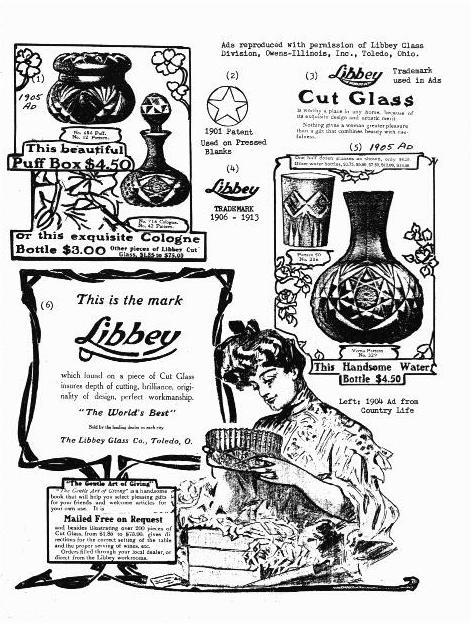National Depression Glass Association
Preserving America's Glass Manufacturing Heritage
Libbey Glass Company - Part I
by Virginia Scott
Glass Review - September 1978
The Libbey Glass Company was a successor of the New England Glass
Company which was founded in East Cambridge Mass, by Deming Jarves in
1818. When New England closed in 1877, the company was leased by their
agent-sales manager, William L. Libbey, who had previously owned Mount
 Washington Glass Works. Two years later Edward D. Libbey joined his
father as a partner in the firm which was called "New England Glass
Works. Wm. L. Libbey & Son, Props." It was during their early years
that Libbey produced "Peachblow," "Agata," "Pamona" and "Amberina,"
glass now classified as "Art Glass" and eagerly sought by
collectors.
Washington Glass Works. Two years later Edward D. Libbey joined his
father as a partner in the firm which was called "New England Glass
Works. Wm. L. Libbey & Son, Props." It was during their early years
that Libbey produced "Peachblow," "Agata," "Pamona" and "Amberina,"
glass now classified as "Art Glass" and eagerly sought by
collectors.
After William Libbey died in 1883, Edward Libbey took control of the company. In 1888, the company was transferred to Toledo Ohio, and the name was changed to "The Libbey Glass Company" in 1892.
Libbey made many kinds of glass and excelled in making fine cut glass. International recognition was gained in 1892 when Libbey built an imposing castle-like building at the Columbian Exposition in Chicago and set up a ten-pot furnace with forty glassblowers. Visitors could walk throuqh the pavilion and see all aspects of glass-making, including blowing and cutting. The "Crystal Art Room" was a major attraction in the pavilion. It had mirrored walls and magnificent exhibition pieces of cut glass were displayed on shelves. Also displayed were spun glass decorating items such as tapestries, firescreens and wall coverings and a fabulous spun glass dress. The dress so impressed Princess Infanta Eulalia of Spain that she commissioned Libbey to make one for her. Souvenir items were sold at the pavilion and each of the two million visitors was given a small spun glass bow on a stickpin. Libbey's exhibits at the Expositon were so successful that Libbey was later able to place their cut glass with the most prestigious stores, including Tiffany.
Libbey was one of the nation's leading producers of fine art glass. Early Libbey pieces were rather simple, using flutes panels and Strawberry Diamond designs. During the Brilliant Period of Cut Glass, loosely dated 1880 to 1920, cuttings became increasingly elaborate and glass became more costly to produce. Only the finest quality glass with high metal content could be used to make the ornate, deeply cut pieces which possessed extraordinary sparkle and brilliance. Favorite motifs for this period were the hob-star, pinwheel and rosette. Some pieces included engravings of hunting scenes flowers and fruits.
The illustration below shows three Libbey ads from 1904 and 1905. Three trademarks which may be found on Libbey cut glass are also shown. No. 6 shows the script "Libbey" with "L" and "y" not connected and a sword underneath, used 1896 to 1906. No. 2, a star within a circle, was used on pressed blanks which ware sold to other companies for cutting. No. 4, "Libbey" in script with "L" and "Y" connected (no sword) were used 1906 to 1913. (References: (1) Libbey: Its History - a Libbey Booklet; (2) Libbey Glass - Toledo Museum of Glass).